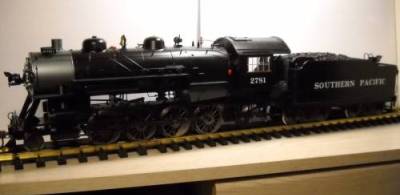I recently received a new Aristo 2-8-0 Consolidation as a gift. This is a fine looking model, and though it is a model of a B&O E-7 locomotive, with some cosmetic work, it can be altered to look like a locomotive from a different railroad. I am going to make mine look like it belongs to the Southern Pacific since that is the road I model.
The 2-8-0 was a regular workhorse on many railroads, and was often seen on branch lines or peddler freights. While it had great pulling power, it was more often seen with about ten assorted freight cars.
This locomotive was one of the most common steam locomotive built and used in both the USA and Canada. The wheel arrangement remained popular with railroads until dieselization. They were a dependable work horse, particularly adept for use on branch line with curve and weight restrictions, where operation of larger locomotives was prohibitive.
Aristo has done a good job on this locomotive, and it really meets the needs for small steam that hobbyists have been asking for. Couplers are supplied and are easily attached to the tender and the pilot. You get both Aristo knuckles and hook and loop. I have not decided whether to use Kadees or Accucraft couplers. An interesting revelation was that the tender is the power pickup for the locomotive. Power is sent to the locomotive through a ribbon cable that plugs into the tender. There are four switches inside the tender which are accessed by popping off the coal load. The switches control DCC/RCC , track or battery power, motor, smoke and lights.
The locomotive requires a minimum 8 foot diameter curve track like its brother the 2-8-2 Mikado. It will pull 4 to 6 passenger cars or 10-15 freight cars depending upon grade and track curvature. Because it uses a proven power and gear train, the locomotive runs very smoothly. It crawls nicely, and has a top speed that is equivalent to that of the real locomotive. One nice touch by Aristo is the inclusion of a fireman and engineer in the cab. They have been painted to look different which alleviates the "twins" look that we have seen in the past. There is a lot of detail added to this locomotive that we have not seen from Aristo previously. Some is molded on, but some is added at the factory. The whistle actually has a cord running back to the cab. Washout plugs have been added to the boiler which are new for Aristo. Injector piping and water lines below the cab have been added along with brake cylinders. My biggest complaint is the plastic piping from the air tanks and pumps. They are fragile and can easily break. I have replaced some with brass rod after I broke them handling the locomotive. They also seem to lead from a tank or pump to nowhere which I have attempted to correct. The steam generator is a separate part that you glue to the top of the boiler. Cab shades are included that must be glued in place. Of course, all grabs and coupler lift bars are wire that have been added at the factory. The tender also has a lot of detail including ladders, coupler lift bar, and handrails. Water valves have also been added to the tender. A backup headlight comes installed on the tender which is functional when the locomotive reverses.
Several people have reported in the forums that the gauge of the drivers was off on this locomotive. I must have gotten lucky, because my drivers were close to the proper spacing based on my Kadee gauge.
A sound system can be easily added to the tender. All connections are plug in. I called Phoenix and ordered some plugs for speaker, variable power and fixed power, since my Phoenix sound system did not come with any.
Southern Pacific Conversion: My conversion is going to start soon. I have to add a proper coupler to the pilot and move the headlight to the center of the smoke box. Per SP prototype practice, the headlight will require a visor, which will be made out of sheet brass. Number boards will be fabricated from styrene and added to the boiler top. The smoke box front will be painted "Old Silver", and cab window frames and the lifters along with the check valve on the boiler will be painted red. SP type blow downs mufflers will be fabricated and added.
The proper tender for this locomotive is a Vanderbilt oil tender. I have done several oil tender conversions, which are very simple. Since I am modeling the SP 2781, the four wheel truck Aristo Vanderbilt tender will be perfect. The complexity of the conversion is stripping out all the electronics from the original tender and installing it along with a sound system in the Vanderbilt tender. Other additions to the tender will be functional markers for the rear per SP practice.
The locomotive will be weathered based on some pictures I have. The tender will be the one that came with the locomotive until I can find a Vandy at the right price.

